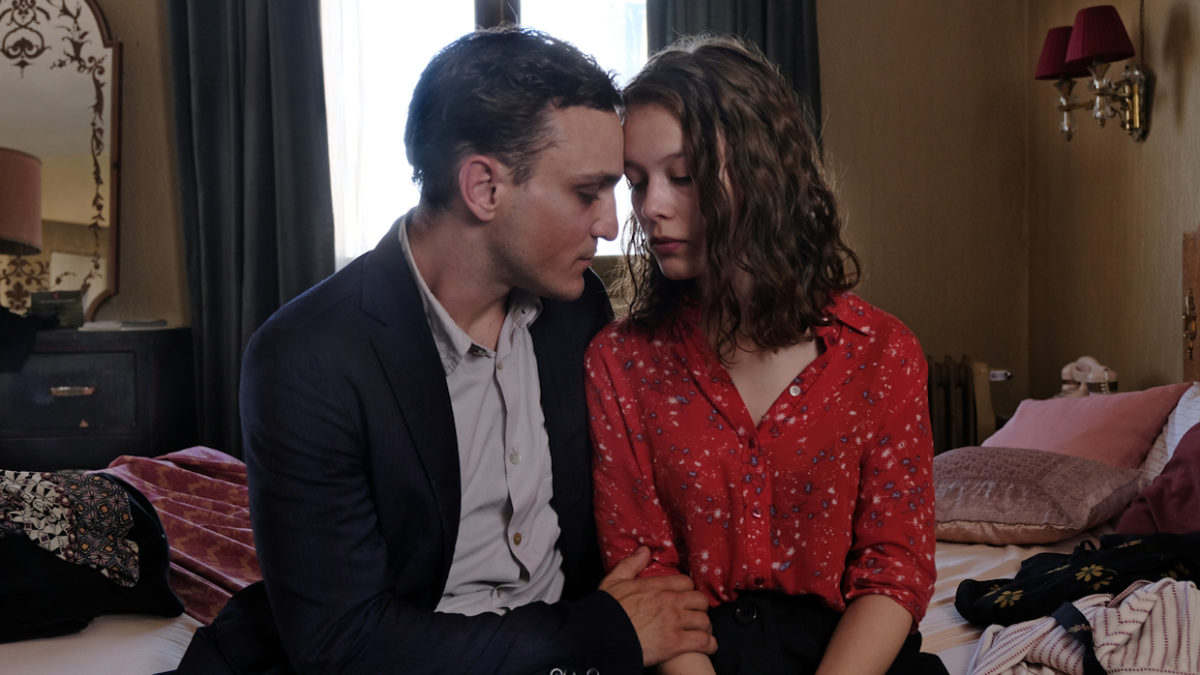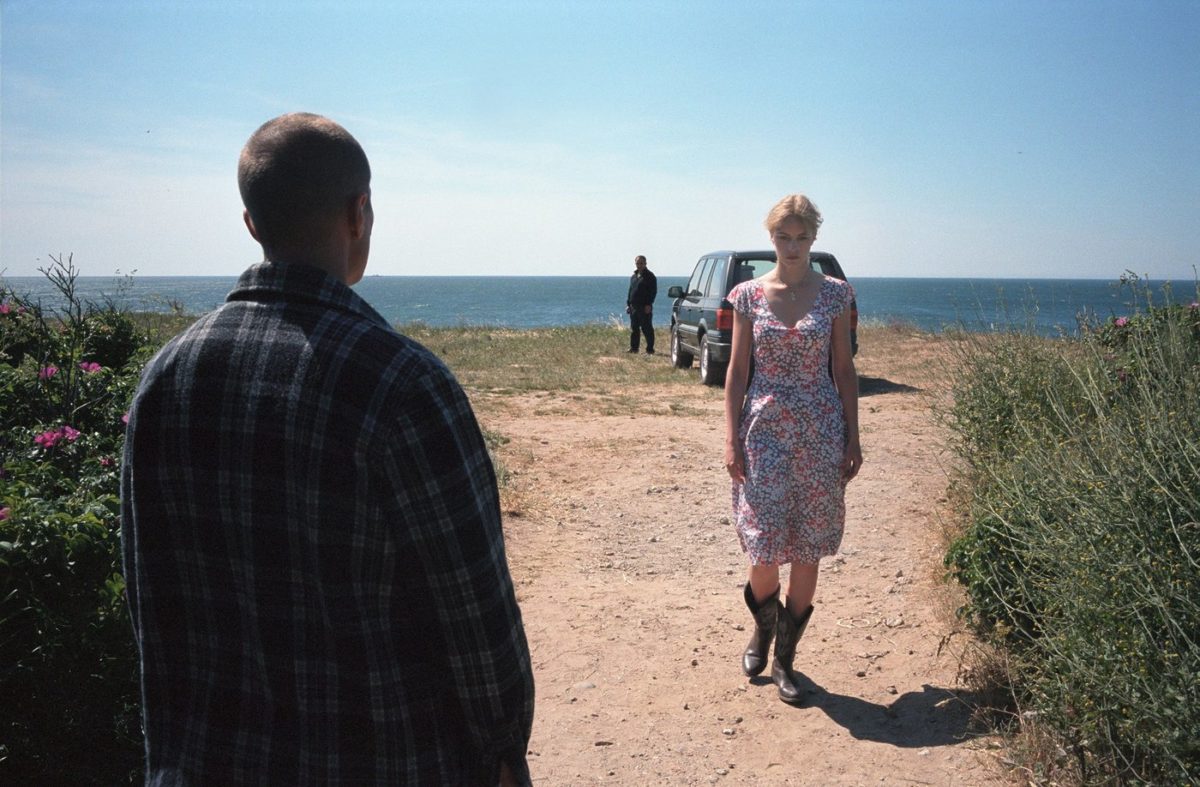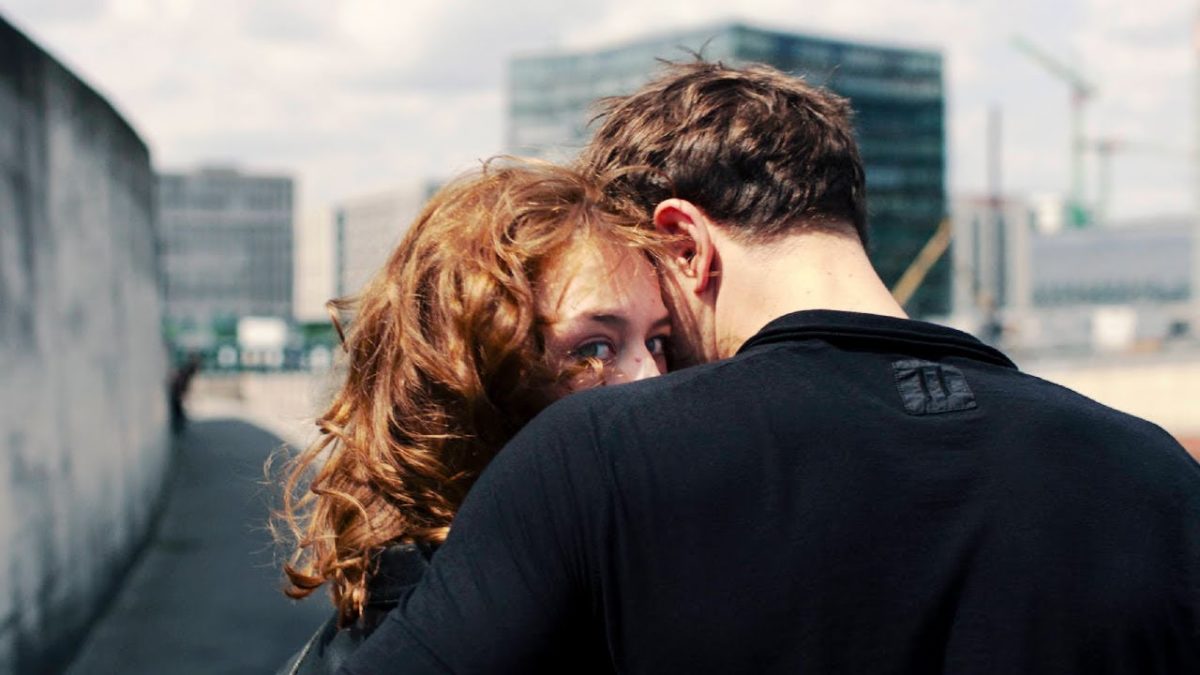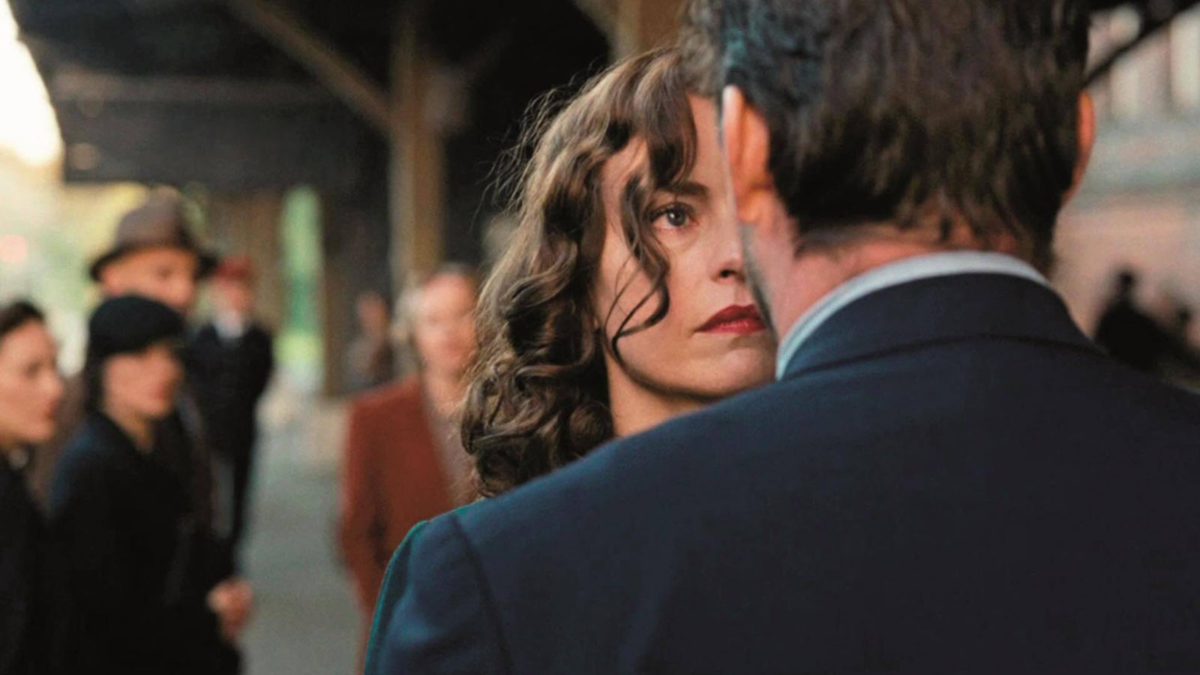The thrust of a passionate embrace can shatter worlds and break wine glasses in the same motion. Such is the case in a sequence halfway through Christian Petzold’s latest film, Undine (2020) where the protagonists Christoph (Franz Rogowski) and the titular Undine (Paula Beer) knock down a prop during a night of lovemaking. Even though the accident itself is kept off screen, it’s made tangible through its aftermath; the aural smash and a red stain on the wall. A trite inconvenience shatters what feels like an impalpable intimacy—their eyes meet and Christoph insists “I’ll fix it, I’m a good painter, I’ll fix it”—resisting to carry on as before. The real has punctured the ideal but as Petzold’s films come to show, life’s only life if there’s room for uncertainty in a determined course. Undine bears its burgundy-coloured scar as noble insignia, being the one Petzold film that grants star-crossed lovers a chance of actual togetherness. Later, when Christoph frantically rushes into that same apartment, searching for his significant other, he will find another couple living there but the wine stain remains. In his films, Petzold gestures towards an ever-present singularity that shines through best in mutable circumstances, and by making these symbols material rather than abstract, he makes a statement about truths in film genres, history, and love.
Concretising symbolism, on the one hand, seems contradictory as the movement from particular object to abstract meaning has been a philosophically viable way to construct fiction. Christian Petzold embraces storytelling and fiction-making but prefers to ground rhetorical tropes and draw attention to some quasi-magical properties of the everyday. By counter-intuitively drawing symbols back into their material shells, the director underscores the substantial relationship between signs and meaning. This may seem at odds with the fact that one of the most accomplished things about Petzold’s filmmaking is how he dramatizes slight impossibilities by representing how things (or people) don’t fit. In doing so, he makes a case for the ethical potential of chance and fate combined, for which the Greeks had a specific word, kairos, meaning an opportune, best-fitting moment. Maybe one of the main traits that ties Petzold to the so-called Berliner Schule, outside the fact that he studied at the capital’s Deutsche Film- und Fernsehakademie Berlin (DFFB) at the same time as future prominent filmmakers Angela Schanelec and Thomas Arslan, is that his films give Germany a long-denied type of representation. Whether it’s a focus on quotidian working-class life (Jerichow, 2008), or a reinvented neorealism (Transit, 2018)—which German cinema never got to experience—Petzold’s films are often described as being about “the here and now.” There’s something oddly R/romantic in seeing Christian Petzold as a contemporary poet of post-war Germany, with his marginalised characters that could easily slip between the cracks of an established social order. Mostly, critics have attributed the ethical stakes and political stance of his works to a certain specificity—of locations, professions, and class culture. But I think they have more to do with reimagining, rather than representing, a reality that invites further explorations. Fitting to his inner Romantic calling—very German indeed—he quoted Joseph von Eichendorff by heart when I interviewed him in Berlin earlier this year. He said:
“The world in itself is an enchanted place, if only we find the right words to explain it. And if we can describe it, then the world would be richer again. Because capitalism, as we see it, is destroying this magic, is disenchanting the world around us and renders everything tradeable, like goods and commodities. So cinema is that place where this magic still exists. Cinema has the power to re-enchant the world.”
His close ties with genre and tradition, be it Hitchcock, Fassbinder, or Sirk; his drawing inspiration from John Carpenter, Buster Keaton, Chaplin, Laurel and Hardy, or myths and recent German history alike: these traits rely on a supporting thread of historicity and self-consciousness. Petzold thinks of himself as “digging in the graveyard of genre,” corroborating how film scholar Jaime Fisher describes his cinema as a “ghostly archaeology of genre.” Indeed, he uses multifaceted narrative hoops, variations, and interactions, to reimagine the beating heart of genre cinema (or B-movies, as he frequently calls them), merging bold artificiality and hyperrealism to conjure a complex mode of moral legibility. The political stakes of articulating what a director deems ethical or not imbue the film form and invite participation from the audience. This interaction is exemplified by what I’m going to call material symbols, or tokens of recognizability—objects that serve as linking devices between characters, plot and context.

Things-in-Themselves: From Object to Symbol
All of Petzold’s films have a penchant for melodrama and thriller elements, some acquire noir-ish characteristics while others keep up more of a straight stylistic face. One should not be tempted to take hyperbole out of the equation to make sense of his melodramatic traits, and simply venture in with a clear understanding that plausibility and realism do not necessarily go hand in hand. Though, none of his films’ plots would make a good one-liner or a simple summary since Petzold cultivates a critical distance by layering symbolism.
In Transit (2018), a film based on Anna Seghers’ novel of the same name and replete with echoes of Michael Curtiz’s Casablanca (1942), missing passports become the reason for two people to meet and fall in love. Documents, love letters, transit permits—all get talked about but are rarely shown. They exist as a narrative drive—as suggested by the film’s title—for Marie (Beer) to escape to Mexico with her husband Georg, who’s passed away but is impersonated by Rogowski’s character. Becoming instrumental (as tools) to their escape, the permits acquire political and symbolic functions. On the other hand, earlier in his career, Petzold emphasised more heavily the significance of passports as obstacles to recognition, rather than tokens in favour of it. Cuba Libre (1996), his first feature after graduating from DFFB, is also about two people who keep missing each other. A riff on Edgar G. Ulmer’s noir Detour (1945), it ultimately sees the two protagonists divided after the man gets involved with a mysterious rich businessman whose bank accounts provide a getaway option. In a tense sequence near the film’s end, Tom (Richy Müller) digs in the dirt to steal the dead man’s passport and vault key, while the camera is glued to these objects that become a symbol of desired freedom. Ultimately, these possessions will—as in a gangster film—be the reason for Tom’s wrongful death and ultimately make the couple’s togetherness impossible, stipulating a more conventional approach to material symbolism in tune with the conventions of the crime thriller genre.
Other times, objects can serve as hidden guidance to untangle the multiple ways in which narrative layering is constructed. For example, in a very short sequence in his first theatrical release, The State I Am In (Die innere Sicherheit, 2000)—a road movie/thriller which follows two former Baader–Meinhof Group operatives and their teenage daughter, Jeanne (Julia Hummer)—the protagonists meet up with an elderly man by using a book as a token of recognition: Herman Melville’s Moby Dick, which Petzold himself has cited multiple times as one of his favourite novels. The man strikes up conversation by referencing an unedited version of Melville’s novel, in which it’s made even clearer that all life is drawn to water, especially people who have lost their way. Moby Dick becomes a key to unlock the role of water in Petzold’s films. The aquatic motif also permeates the double premise of late capitalist thriller Yella (2007), in which a plot twist reveals that Nina Hoss’s titular character was reimagining a string of events while drowning after a fatal car accident. While the focus seems to be on the role of capitalism and Yella’s attempt to escape the social structure that governs it, it’s important to flag the presence of water (aurally through swooshing sounds and visually as ripples and waves) as symbolic in a similar—fluid rather than material—guiding way.
Undine is born out of that fascination with water. In the film’s opening sequence, Undine tells Johannes (Jacob Matschenz) amidst their breakup that if he leaves her, she’ll have to kill him, point blank. Undine (her name says it all) doesn’t need a storyteller to vouch for her but the film only hints at her mythological nature, making a full-blown projection of male desire out of Paula Beer’s character, and gesturing to the emancipation that she’ll later pursue in her romance with the tender working-class hunk Christoph. The meeting between them carries a certain fairy-tale fatalism and takes place soon after that breakup.
While searching for Johannes, Undine stands right below a big decorative aquarium. The viewer’s eye is drawn to the small figurine of an industrial diver in a shot-counter shot composition, as inexplicable tension rises with the bubbling water. What’s there to go wrong? The camera cuts to a man entering the room, expressing a timid gratitude for Undine’s lecture on Berlin’s urban topography. “I’m an industrial diver,” he says, with a muffled voice sinking in the background as we’re cast into a new vantage point. The scene is now observed from inside the aquarium from the figurine’s point of view—a rather awkward spatial change—blocked by a goldfish or two. This change of perspective anticipates the meet-cute between the protagonists, as the aquarium bursts into tiny pieces and both Undine and Christoph drop to the ground, drenched and covered with seaweed. Water splashes over them in a singular motion, while rapid cuts construct a scene of high-intensity, a more hard-paced and concentrated sequence than any other moment in the film. It’s no wonder that the diver figurine ends up in Undine’s hands, as a token of recognition: all the underwater sequences that show Christoph working involve long shots that frame him as a miniature diver. The link between reality and symbol here is almost totemic.
Another form of material symbolism can be found in Petzold’s 1980s DDR drama Barbara (2012), the film that brought him the Berlinale Silver Bear for Best Director and Nina Hoss the Silver Bear for Best Actress. In a much-cited sequence, André (Ronald Zehrfeld) recites to the newcomer in his hospital staff, Barbara (Hoss), an interpretation of Rembrandt’s 1632 oil painting The Anatomy Lesson of Dr. Nicolaes Tulp. Significant readings here point to the metatextuality and the connotation between media forms, as André uses analytical tools to convey truths about his attitude towards the West and the DDR’s regime of surveillance. The oil painting (a replica, nonetheless), presents what scholar W. J. T. Mitchell calls ‘metapictorialism’, in that by misplacing moral and political judgements about the present onto an image, it becomes a means of presenting a material truth to Petzold’s own audience.

Stories They Tell: How Symbols Disrupt Narrative Patterns
Nevertheless, while a degree of self-referentiality can be observed in each of Petzold’s films, he is, in fact, never really repeating himself. Sometimes, this manifests itself as prediction rather than a concrete visual equivalent. In the Holocaust melodrama Phoenix (2014) Johnny’s (Zehrfeld) guess about how the family will greet Nelly (Hoss) as a Holocaust survivor at the train station, comes true. In Transit, the almost-identical staging of a single location over multiple sequences renders Marseille labyrinthine but the iterations also bestow upon it an expected familiarity.
It’s rare that things run their course and the future can be successfully predicted, thus tamed. Most often, like in Jerichow (2008), life doesn’t always accommodate one’s plans. Loosely based on James M. Cain’s novel The Postman Always Rings Twice, the film presents Nina Hoss as a femme fatale, making use of the novelistic themes of betrayal and forbidden love, to take the shape of a film noir, its stylistics rendered more banal to fit the small-town working-class aesthetics of the titular town in the East of Germany. Even if Thomas (Benno Fürmann) and Laura’s (Hoss) illicit affair drives them to plan her husband Ali’s (Hilmi Sözer) murder, it’s the unpredictable factor of human fallacy that gets in the way. Laura’s expression softens with imminent grief as she narrates the murder plot, her sentences are spoken in the past tense as if recalling a dream but, in fact, she’s referring to a future time. The plan backfires because of a small car-shaped key ring, a token of friendship and identity, signifying the plotting of an automobile accident. The film’s final sequence plays out as all three protagonists are drawn to this sudden realisation in a single frame, forming a love triangle with the material symbol in the middle. The end of Undine replicates a similar structure when Christoph emerges from the dam, having answered Undine’s call for him. He’s clutching the diver figurine with one hand and his new wife’s hand with the other. The camera’s point of view is just above the water surface, marking a narrative turning point. While in Jerichow, this triangle stands for the downfall of the couple’s plans, Undine reworks it as a scene of absolution: the sea spirit has given Christoph up by gifting him the figurine, she has set him free and will not kill him for taking a new lover.
The idea that once recognised, you will be set free, makes out of the material symbol somewhat of a narrative ‘helper’, typical for traditional fairy-tale narratives. In the middle of Ghosts (Gespenster, 2005), Françoise (Marianne Basler), a French woman recently released from a psychiatry clinic, believes that Nina (Hummer), an adolescent orphan who has just become infatuated with slightly older Toni (Sabine Timoteo), is her lost daughter. Francoise insists that recognition is possible with the help of body marks: a scar on the ankle and a heart-shaped freckle on the back, recalling Ulysses and ancient mythology. The meeting is also staged as a triangle: between the aggressive Toni, Nina, and the pleading woman, with the potential overlap of identities fuelling the image with even more tension. When Françoise insists to see her ankle, Nina’s feet are kept off screen in a medium-long shot. Right after, the shot cuts to a close up of her leg, suspended over the other, her fingers pulling down the sock to reveal a scar. Treated with special attention in a conventional cinematic grammar of suspense, the meeting becomes an opportunity for a woman to share her story of grief and repentance, producing an aura of mystery and second-guessing. The heart-shaped skin pigmentation becomes a material symbol of recognition. But we never get to see it.
In the following sequence, Nina asks Toni to take a look at her back in front of a wide bathroom mirror. The mere fact that the symbol is unreachable for the bearer herself already posits a contradiction and the aesthetic arrangement of the frame aggravates it, blocking the audience’s direct access to the body part in question. We see Toni in the foreground, facing Nina’s back but Nina herself is barely visible, covered by Toni’s figure. The scene’s sense of space exceeds the frame because of the mirror. The staging here is complicated on purpose but it all works together (with the contrast of dark colours and bathroom LED lights at the edge of the frame) to conceal rather than reveal. This sequence that holds the big secret of Ghosts, is choreographed in order to exclude the viewer and ignite doubt by obscuring its bearer of meaning with a simple arrangement of mise-en-scène. Petzold relies on blocking and concise framing in static compositions to build a self-sufficient world within the margins of each shot and has perfected his technique of capturing the everyday in imaginative ways as if he’s used to beholding the most banal space until it becomes mysterious again.
He also doesn’t go for the most obvious of symbols. In Phoenix, Petzold’s response to the Versöhnungsfilmen (German ‘reconciliation’ films of the mid to late-1990s and the 2000s) and Fassbinder’s The Marriage of Maria Braun (Die Ehe der Maria Braun, 1978), it’s not the concentration camp number scaring Nelly for life that makes her husband finally recognise her, it is the way her falsetto soars in the chorus of Kurt Weill’s ‘Speak Low’. A song is undoubtedly less material than a tattoo (especially one swollen with the trauma of its cultural significance) but performance here grounds the symbols, making them something more than mere metaphors. The Petzold-Hoss collaboration has been one of the most discussed idiosyncrasies of the filmmaker’s work, even more than his usual team-up with cinematographer Hans Fromm or editor Bettina Böhler (significant for editing many of the Berliner Schule’s films). Lauded by critics and presented with awards, Nina Hoss’s place in Petzold’s films is indispensable not only because of her corporeal resilience from role-to-role but also for its free-flowing interpretation of what material symbolism is. In Phoenix, particularly, the film benefits from both her acting and her character’s point of view of a knowing woman, as in, the one who is aware of the narrative premise in full (unlike Johnny), but refuses to take control over it until the very end. For example, the plot’s oscillation between points of view mirrors the way each of the two protagonists see each other, and opens up space for the potential tragedy of missing each other.

Symbols Regained
The recurrence of missed encounters over the course of each individual film resonates within his whole oeuvre but particularly so in Undine. Petzold shows Undine’s speech on urban construction three times as she recites it herself, and once more recited by her colleague after she’s disappeared. Both Undine and Christoph traverse the same path to (the fictional) Hofcafe three times and three times back from it. The tensions of turning a corner and searching for someone with your eyes only is enhanced by the fact that we’ve already seen this sequence. She peeks from the high window of her office building that overlooks the courtyard with the cafe tables, twice, from the same position on the stairs. Petzold’s staging is precise but ultimately acquires contextual meaning when the narrative advances. His latest film Undine enables him to use the titular myth to make a point about being stuck in circular narratives, self-fulfilling prophecies and the cyclical approach to time as an inescapable curse. It took many attempts for his characters to assume a position of singlehandedly leading their own story. It’s Undine who reclaims her first person perspective and breaks the cycle.
And what drives the narrative forward? The consecutive alterations and the shifting within patterns. Petzold’s films remain strictly (but not suffocatingly) ordered; his move away from patterns is always gradual, with certain variations intertwining to adjust the course of events, as if tuning into a slightly different frequency. This is an ethical stance as well: keeping patterns and their variations under precise control—both narratively and formally. Throughout his films, Petzold’s characters seek each other out through identifying marks and material symbols, which makes his mode of storytelling one free of narrators. Everyone is a potential protagonist and usually it’s not the main character who’s the champion of their own story. Furthermore, even objects act as depositories of their respective micro-histories and it’s the characters’ duty to either unearth or re-enact them anew. By giving the floor to alternative (hi)stories and symbols, Petzold acknowledges the potential of every storyteller to make use of their own desires and aims, and to set the dramatic irony aside. In a way, material symbols retain the best of both worlds—their meaning-making function entwined with their instrumental purpose. After all, what’s left of this world, if we can’t can rely on objects to re-enchant it once again?
